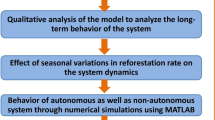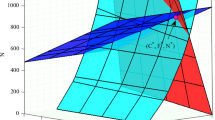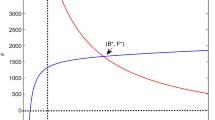Abstract
The anthropogenic carbon dioxide \((CO _2)\) emission from the burning of fossil fuels is the prime cause behind the menace of global warming. Over the past few decades, fossil fuel consumption has increased drastically to fulfill the energy demand of the growing population and economy. The population pressure has not only contributed to the increase in fossil fuel consumption but also accelerated the deforestation for industrial, agricultural, and infrastructure expansion. This paper presents a nonlinear mathematical model to study the effect of an increase in fossil fuel use and deforestation due to population pressure on atmospheric carbon dioxide concentration. Further, the effect of economic efforts applied to reduce the population pressure over the control of atmospheric \(CO _2\) levels is explored. The model analysis shows that an increase in the fossil fuel consumption rate causes an increase in the equilibrium level of carbon dioxide. Further, it is found that an increase in the deforestation rate coefficient has a destabilizing effect on the stability of positive state of the system. If the deforestation rate crosses a critical threshold, the positive state of the system loses stability and the periodic solutions arise via Hopf-bifurcation. It is shown that at high deforestation rates, an increase in the implementation rate of economic efforts applied to reduce the population pressure may cause reduction in the amplitude of periodic oscillations. The periodic oscillations may disappear if the implementation rate of economic effort increased beyond a critical threshold and the concentration of carbon dioxide gets stabilized.













Similar content being viewed by others
References
McMichael AJ, Woodruff RE, Hales S (2006) Climate change and human health: present and future risks. Lancet 367:859–869
Casper JK (2010) Greenhouse gases: worldwide impacts. Facts On File Inc, New York
Shuman EK (2010) Global climate change and infectious diseases. N Engl J Med 362:1061–1063
United Nations Climate Change (2019) Climate action and support trend. https://unfccc.int/sites/default/files/resource/Climate_Action_Support_Trends_2019.pdf. Accessed 20 June 2023
Yang J, Zhou M, Ren Z, Li M, Wang B, Liu DL, Ou CQ, Yin P, Sun J, Tong S, Wang H, Zhang C, Wang J, Guo Y, Liu Q (2021) Projecting heat-related excess mortality under climate change scenarios in China. Nat Commun 12:1039
National Oceanic and Atmospheric Administration (2022) Trends in atmospheric carbon dioxide. https://gml.noaa.gov/ccgg/trends/. Accessed 20 June 2023
Ritchie H, Roser M, Rosado P (2022) Energy. https://ourworldindata.org/energy-mix. Accessed 20 June 2023
Le Quere C et al (2018) Global carbon budget 2018. Earth Syst Sci Data 10:2141–2194
Ritchie H, Roser M, Rosado P (2020) \(CO\it _2\) and Greenhouse Gas emissions. https://ourworldindata.org/emissions-by-fuel. Accessed 20 June 2023
FAO (2020) Global forest resources assessment 2020-Key findings, Rome https://doi.org/10.4060/ca8753en. Accessed 20 June 2023
Dubey B, Sharma S, Sinha P, Shukla JB (2009) Modelling the depletion of forestry resources by population and population pressure augmented industrialization. Appl Math Model 33:3002–3014
Misra AK, Lata K, Shukla JB (2014) A mathematical model to for the depletion of forestry resources due to population and population pressure augmented industralization. Int J Model Simul 5(1):1350022
Misra AK, Lata K, Shukla JB (2014) Effects of population and population pressure on forest resources and their conservation: a modeling study. Environ Dev Sustain 16:361–374
Lata K, Misra AK, Shukla JB (2018) Modeling the effect of deforestation caused by human population pressure on wildlife species. Nonlinear Anal: Model Control 23:303–320
Misra AK, Jha A (2021) Modeling the effect of population pressure on the dynamics of carbon dioxide gas. J Appl Math Comput 67(2):623–640
Misra AK, Lata K (2015) Depletion and conservation of forestry resources: a mathematical Model. Differ Equ Dyn Syst 23(1):25–41
Tennakone K (1990) Stability of the biomass-carbon dioxide equilibrium in the atmosphere: mathematical model. Appl Math Comput 35:125–130
Caetano MAL, Gherardi DFM, Yoneyama T (2011) An optimized policy for the reduction of \(CO_2\) emission in the Brazilian legal Amazon. Ecol Model 222(15):2835–2840
Misra AK, Verma M (2013) A mathematical model to study the dynamics of carbon dioxide gas in the atmosphere. Appl Math Comput 219(16):8595–8609
Misra AK, Verma M (2015) Impact of environmental education on mitigation of carbon dioxide emissions: a modelling study. Int J Global Warming 7(4):466–486
Misra AK, Verma M, Venturino E (2015) Modeling the control of atmospheric carbon dioxide through reforestation: effects of time delay. Model Earth Syst Environ 1-24
Shukla JB, Chauhan MS, Sundar S, Naresh R (2015) Removal of carbon dioxide from the atmosphere to reduce global warming: a modeling study. Int J Glob Warm 7(2):270–292
Verma M, Misra AK (2018) Optimal control of anthropogenic carbon dioxide emissions through technological strategies: a modeling study. Comp Appl Math 37:605–626
Devi S, Gupta N (2019) Dynamics of carbon dioxide gas(\(CO_2\)): effects of varying capability of plants to absorb \(CO_2\). Nat Resour Model 32:e12174
Devi S, Gupta N (2020) Comparative study of the effects of different growths of vegetation biomass on \(CO _2\) in crisp and fuzzy environments. Nat Resour Model 33:e12263
Devi S, Mishra RP (2020) Preservation of the forestry biomass and control of increasing atmospheric \(CO _2\) using concept of reserved forestry biomass. Int J Appl Comput Math 6:17
Verma M, Verma AK, Misra AK (2021) Mathematical modeling and optimal control of carbon dioxide emissions from energy sector. Environ Dev Sustain 23:13919–13944
Verma M, Verma AK (2021) Effect of plantation of genetically modified trees on the control of atmospheric carbon dioxide: a modeling study. Nat Resour Model 34:e12300
Verma M, Gautam C (2022) Optimal mitigation of atmospheric carbon dioxide through forest management programs: a modeling study. Comput Appl Math 41:320
Tandon A (2023) Mathematical modelling and analysis to study the impact of mining on natural interactive dynamics between plants and carbon dioxide. Model Earth Syst Environ 9:97–110
Nikol’kii MS (2010) A controlled model of carbon circulation between the atmosphere and the ocean. Comput Math Model 21:414–424
Zabel G (2009) Peak people: the interrelationship between population growth and energy resources. https://www.resilience.org/peak-people-interrelationship-between-population-growth-and-energy-resources. Accessed 20 June 2023
Onozaki K (2009) Population is a critical factor for global carbon dioxide increase. J Health Sci 55:125–127
Jorgenson AK, Clark B (2013) The relationship between national-level carbon dioxide emissions and population size: an assessment of regional and temporal variation, 1960–2005. PLoS One 8(2):e57107
Kurane I (2010) The effect of global warming on infectious diseases. Osong Public Health Res Perspect 1:4–9
Hassard BD, Kazarinoff ND, Wan YH (1981) Theory and applications of Hopf-bifurcation. Cambridge University Press, Cambridge
Hale JK (1969) Ordinary differential equations. Wiley-Interscience, New York
Freedman HI, So JWH (1985) Global stability and persistence of simple food chains. Math Biosci 76:69–86
Bortz DM, Nelson PW (2004) Sensitivity analysis of a nonlinear lumped parameter model of HIV infection dynamics. Bull Math Biol 66:1009–1026
Funding
The research work of Alok Kumar Verma is supported by Council of Scientific & Industrial Research (CSIR), New Delhi, India, in the form of Senior Research Fellowship (09/961(0014)/2019-EMR-1).
Author information
Authors and Affiliations
Corresponding author
Ethics declarations
Conflicts of interest
The authors declare that there is no conflict of interests regarding the publication of this article.
Additional information
Publisher's Note
Springer Nature remains neutral with regard to jurisdictional claims in published maps and institutional affiliations.
Appendices
Appendix
A Proof of Lemma 1
From the fourth equation of the model system (1), we have
By comparing the above differential inequality with the differential equation
and using a standard comparison theorem [37, 38], we get
Let \(\epsilon >0\) be given. Then \(\exists \) \(t_0>0\) such that
This implies that
From the third equation of model system (1), we have
This implies that
From the second equation of the model system (1), we get
which implies that
From the first equation of model system (1), we have
which implies that
This proves the lemma.
B Proof of Lemma 2
From the fourth equation of the model system (55), we have
This implies that
The third equation of model system (55) gives
This implies that
From the second equation of the model system (55), we have
This implies that
From the fifth equation of model system (55), we have
This implies that
From the sixth equation of system (55), we get
This implies that
From the first equation of model system (55), we have
which implies that
This proves the lemma.
Rights and permissions
Springer Nature or its licensor (e.g. a society or other partner) holds exclusive rights to this article under a publishing agreement with the author(s) or other rightsholder(s); author self-archiving of the accepted manuscript version of this article is solely governed by the terms of such publishing agreement and applicable law.
About this article
Cite this article
Verma, M., Verma, A.K. & Gautam, C. Mathematical modeling of mitigation of carbon dioxide emissions by controlling the population pressure. J Eng Math 142, 2 (2023). https://doi.org/10.1007/s10665-023-10287-2
Received:
Accepted:
Published:
DOI: https://doi.org/10.1007/s10665-023-10287-2




